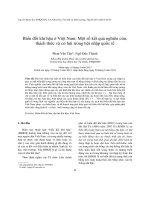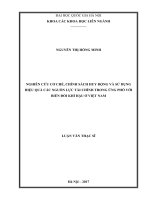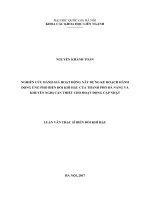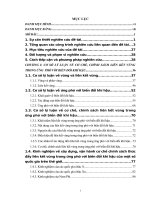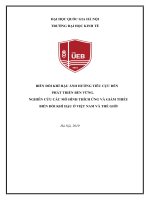Nghiên cứu cơ chế chính sách nhằm huy động nguồn lực tài chính từ khu vực tư nhân trong hoạt động ứng phó với biến đổi khí hậu ở việt nam TT TIENG ANH
Bạn đang xem bản rút gọn của tài liệu. Xem và tải ngay bản đầy đủ của tài liệu tại đây (392.04 KB, 26 trang )
MINISTRY OF NATURAL RESOURCES AND ENVIROMENT
VIET NAM INSTITUTE OF METEOROLOGY
HYDROLOGY AND CLIMATE CHANGE
PHAM THI THU HUONG
RESEARCH ON MECHANISMS AND POLICIES TO
MOBILIZE FINANCIAL RESOURCES FROM THE
PRIVATE SECTOR IN RESPONSE TO CLIMATE CHANGE
IN VIET NAM
Major: Climate change
Code: 9440221
Ph.D DISSERTATION SUMMARY
Ha Noi, 2022
Dissertation has been completed at:
Viet Nam Institute of meteorology hydrology and climate change
Supervisors:
1. Ph.D. Nguyen Van Tai
2. Assoc.Prof. Hoang Van Hoan
Reviewer 1: Assoc.Prof. Nguyen The Chinh
Reviewer 2: Assoc.Prof. Nguyen Tien Giang
Reviewer 3: Assoc.Prof. Nguyen Tuan Anh
The Dissertation will has been defended at Viet Nam Institute of
Meteorology, Hydrology and Climate Change at …….. …………….
The dissertation is available of the Viet Nam Institute of Meteorology,
Hydrology and Climate Change
1
INTRODUCTION
1. Background
Climate change (CC) increases risks, increases vulnerability, and
affects all economic sectors of countries worldwide, especially
developing countries, including Viet Nam. When Viet Nam is facing
the economic and health impacts of the COVID-19 pandemic, allocating
the state budget (state budget) to respond to climate change faces many
difficulties and challenges that are expected not enough to meet the
growing demand. Therefore, promoting the mobilization of financial
resources from the private sector for climate change response is one of
the top priorities to enhance the implementation capacity and ensure the
effectiveness of the climate change response policies of Viet Nam after
2020. The Party’s Resolutions also emphasize the need to diversify
capital sources and mobilize financial resources to implement climate
change response activities.
Numerous studies have demonstrated that investor concerns
impact investment decisions in climate change response projects. Thus,
if these factors can be addressed, policy tools significantly impact the
private sector’s decision to participate in climate change response.
2. Objectives
- Evaluate the role of the private sector in responding to climate
change in Viet Nam;
- Determine the factors influencing the private sector’s investment
decision in response to climate change in Viet Nam;
- Evaluate the successes and shortcomings in promoting
investment decisions of the private sector and propose solutions to
2
create an enabling environment for private sector investment in
responding to climate change in Viet Nam.
3. Subject and scope of the research
The subject of the study: The thesis examines the private sector’s
role in responding to climate change and theoretical and practical factors
influencing private enterprise investment decisions in climate-related
activities/projects.
Scope of the research: The thesis is devoted to exploring and
surveying the private sector, including private enterprises, limited
companies, and joint-stock companies (with no or less than 50% state
capital) (details in section 1.1.2). Climate change response
projects/activities include mitigating GHG emissions and adapting to
climate change. As a result, the selected businesses operate in affected
areas and have adaptation and mitigation measures in places, such as
renewable energy, agriculture and processing, industry, technology, and
construction.
4. Research question and hypothesis
4.1. Research question
- What role does the private sector play in Viet Nam’s response to
climate change?
- What are the critical factors influencing the private sector’s
investment decisions in response to climate change in Viet Nam?
- What are the shortcomings in the mechanisms and policies that
have impacted the private sector’s investment decisions in response to
climate change in Viet Nam?
- What measures must be taken to foster the private sector’s
investment decisions in response to climate change in Viet Nam?
3
4.2. Hypothesis
- The private sector plays a critical role in Viet Nam’s response to
climate change;
- Several factors influence private enterprise investment decisions
(or willingness) in climate change response projects. Thus, these factors
should be incorporated in mechanisms and policies for mobilizing
private sector investment in Viet Nam’s response to climate change;
- Apart from accomplishments, there are still some gaps in
promoting private sector investment decisions in response to climate
change in Viet Nam;
- There are ways to foster an enabling environment for private
sector investment decisions in response to climate change in Viet Nam.
5. Methodology
- The data collection and desk research methods were used to
establish the scientific foundation for evaluating the factors influencing
the private sector’s investment decisions in climate change response
projects. Analyze, establish evaluation criteria, and recommend
mechanisms and policies based on the factors affecting enterprise
investment decisions;
- The questionnaire survey method was used to collect data for
statistical analysis of the factors affecting enterprises’ investment
decisions in response to climate change;
- Statistical methods such as exploratory factor analysis (EFA) and
linear regression analysis were used to analyze the questionnaire
responses to determine the factors affecting the private sector’s
investment willingness, or what is referred to in this thesis as the factors
4
affecting enterprises’ investment decisions in climate change response
projects.
6. New contributions of the thesis
- Through sociological investigation of entrepreneurial behavior,
the thesis evaluated and identified the critical factors influencing the
private sector’s investment decision in climate change response projects
in Viet Nam;
- The thesis assessed the effectiveness and shortcomings of
mechanisms, policies, and proposed solutions to promote private sector
investment decisions in response to climate change in Viet Nam.
7. Scientific and practical implications
7.1. Scientific implications
Through research on entrepreneurial behavior, the thesis develops
assessment methods and policies for mobilizing financial resources
from the private sector to address climate change. The thesis’s research
findings will contribute to supplementing and completing the
methodology and research methods for mobilizing resources from the
private sector in response to climate change in Viet Nam, emphasizing
increasing enterprise willingness to implement mobilization policies
and mechanisms.
7.2. Practical implications
Promoting the mobilization of private financial resources to
address climate change is a top priority for Viet Nam to meet the
financial requirements for responding to climate change and alleviate
pressure on public finances. The thesis’s findings will contribute to
developing comprehensive mechanisms and policies for mobilizing
5
financial resources from the private sector in Viet Nam’s response to
climate change.
Additionally, the thesis establishes a foundation for subsequent indepth studies and strengthens the students’ research abilities.
8. Thesis outline
In addition to the introduction and the conclusion, the thesis is
structured into three chapters as follows:
Chapter I: Overview of research on mobilizing private sector
investment for climate action.
Chapter II: Methodology and data for determining the factors that
affected the private sector’s investment decisions in response to climate
change in Viet Nam.
Chapter III: Research results and solutions for promoting private
investment decisions in response to climate change in Viet Nam.
6
CHAPTER I. OVERVIEW OF RESEARCH ON MOBILIZING
PRIVATE SECTOR INVESTMENT FOR CLIMATE ACTION
1.1. Definition of the private sector and financing investment
mobility in response to climate change
The terms mechanism and policy are used interchangeably in
this thesis to refer to the policies, and economic mechanisms (tools)
used to accomplish specified goals, most notably mobilizing
financial resources from the private sector.
The private (economic) sector is defined in this thesis as private
enterprises as defined by Vietnamese law, which includes private
enterprises, limited companies, and joint-stock companies (without
or with less than 50% state capital).
Mobilizing financial resources from the private sector to address
climate change is a process facilitated by the State’s establishment
and implementation of policies, measures, and instruments aimed at
converting potential financial resources from the private sector into
monetary funds for climate change response purposes.
1.2. The demand to increase financial resources in climate change
response and the role of the private sector in Viet Nam
1.2.1. The requirement for private financial resources mobilization
As a low-middle-income country frequently affected by natural
disasters caused by climate change and heavily impacted by the
COVID-19 pandemic, Viet Nam’s total financial requirement for
greenhouse gas emissions mitigation and climate change adaptation is
enormous. Meanwhile, it is estimated that the private sector
contributes an increasing amount to its socio-economic development.
7
By 2020, the private economic sector will account for 43% of GDP
(approximately 148 billion USD), employ roughly 85 percent of the
workforce,
and
contribute
significantly
to
social
resource
mobilization, economic restructuring, job creation, and wage increases
for workers, particularly in the investment, tourism, urban areas,
automobile manufacturing, high-tech agriculture, and trade in services
sectors. As a result, the private sector’s financial resources are
substantial.
1.2.2 The private sector’s role
Responding to climate change presents the private sector with
both challenges and opportunities. Not only is the private sector
affected by climate change, but it is also a critical resource for
promoting climate change response activities. As a result, it is
necessary to investigate and identify appropriate policies for enticing
potential areas to participate in climate change response activities to
secure implementation resources and capitalize on development
opportunities
toward
a
low-emissions
and
climate-resilient
economy.
1.3. Overview studies on mechanisms and policies to mobilize
private finance in response to climate change
1.3.1. Behavioral science and private sector investment decisions
The decision behavior theory examines and justifies the
selection of a decision-maker. A four-part process governs decision
making: Want, Intention, Action, and Outcome. Additionally,
behavioral finance demonstrates that individuals’ choices are not
entirely rational and do not deviate from rationality randomly but
rather predictable ways. By employing the appropriate statistical
8
models, we can better understand how decisions are made and thus
identify the sound effects to counteract them.
In many cases, understanding the motivations for (in)action can
help individuals improve their decision-making capacity. Climate
projects, in particular, typically involve a diverse range of
organisations, businesses, and individuals. These actors come from
a variety of countries, regions, and sectors of activity, bringing with
them a range of socioeconomic characteristics, abilities, techniques,
capacities, and experiences. Recognize the factors that influence
investment decisions in order to make timely adjustments to increase
climate action participation.
According to various researches, some of the primary factors
influencing enterprises’ investment decisions in climate change
response include: State commitment; the stability of the investment
environment; the reliability of policies; the development of
predictability; import taxes are the most effective renewable energy
policy in some countries; investor perception (about the importance
of climate change); project profit; and insurance promotes risksharing. The group of factors affecting the private sector’s ability to
mobilize capital for climate change adaptation projects includes the
following: the degree of policy precision; effective and efficient
policy institutions; risk reduction; risk-benefit balance; legal system;
and economic environment.
1.3.2. Studies in Viet Nam on mobilizing capital from the private
sector to respond to climate change
There have been few studies in Viet Nam on how to mobilize
financial resources from the private sector to address climate change,
9
with the majority focusing on public investment and the private
sector in development projects. These studies take a top-down
approach (from the perspective of mechanisms and policies) to
analyze and highlight potential factors affecting the effectiveness of
policies aimed at mobilizing private financial resources. However,
several critical issues concerning the efficiency of private finance
mobilization, particularly from the private sector’s perspective, have
not been studied and resolved. In particular, very few studies have
examined the factors influencing enterprises’ investment decisions
in climate change response projects in Viet Nam.
10
CHAPTER 2. METHODOLOGY AND DATA FOR
DETERMINING THE FACTORS THAT AFFECTED THE
PRIVATE SECTOR’S INVESTMENT DECISIONS IN
RESPONSE TO CLIMATE CHANGE IN VIET NAM
METHODOLOGY
• Data collection
MOBILIZE PRIVATE SECTOR INVESTMENT FOR
CLIMATE ACTION STATUS
• Support from the state for climate change response initiatives
• Businesses play a significant role in climate change response
policies.
• Loans for climate change response activities
• Policies for risk sharing and allocation
• Implementation drawbacks
• Examining the factors that
influence investment
decisions in response to
climate change:
• Questionaire
• Exploratory factor
analysis (EFA)
• Linear Regression
FACTORS INFLUENCING
INVESTMENT DECISION
• Desk study
• Identifying the factors influencing enterprise
investment decisions in response to climate change
(bottom up): Analyze the survey results to determine
the factors influencing enterprise investment decisions
in climate change response.
• Assessment of current mechanisms and policies to
mobilize private sector financial resources to address
climate change in Viet Nam (top down):
• Private sector's role in Viet Nam's climate
change response
• Policy evaluation based on the abovementioned factors influencing enterprise
climate change investment decisions
SOLUTIONS & RECCOMENDATIONS
2.1. Research framework
Figure 2.1. Research framework
The research framework of the thesis is shown in Figure 2.1.
Section 5 of the Introduction summarizes data collection and desk
research fundamentals. The following section of the thesis summary
will analyze the factors that influence enterprises’ investment
decisions in response to climate change.
2.2. Top-down and bottom-up multidimensional approaches
Through collected documents, the thesis takes a top-down
approach to evaluating mechanisms and policies for mobilizing
financial resources from natural areas to address climate change in
Viet Nam. Bottom-up approaches are used to ascertain the factors
11
influencing enterprises' investment decisions in response to climate
change based on the impact of their behavior and attitudes on
investment decisions.
2.3. Data collection methods and desk research
2.3.1. Secondary data collection
Numerous
studies
conducted
both
domestically
and
internationally on mobilizing financial resources from the private
sector and evaluating state mechanisms and policies for mobilizing
financial resources from the private sector in response to climate
change were gathered and analyzed.
2.3.2. Sociological investigation methods
The survey process is divided into two phases: preparation,
which includes a pilot study with 30 private enterprises engaged in
climate change response activities (December 2009), and main
research, which involves 150 private enterprises (from January 1 to
March 2020).
The Likert-5-point scale used in the questionnaire was
developed based on research into the factors influencing investment
willingness in climate change response activities. The scale of
factors affecting the private sector's participation in climate change
response projects in Vietnam includes the following: (1) investment
intention; (2) private sector attitudes; (3) state support; (4) lender
support; (5) investment environment; (6) private sector capacity and
experience; (7) project characteristics; and (8) service users' support
(specific scales are shown in Table 2.2 in the thesis).
12
2.3.3. Desk study method
The evaluation and analysis of the thesis were conducted using
the desk study method.
2.4. Methods for determining the factors affecting the private
sector’s investment willingness
SPSS software (Statistical Product and Services Solutions)
was used to conduct statistical analysis. The following are the
primary steps in EFA analysis:
Step 1: Develop and validate the scale’s quality using
Cronbach’s Alpha and Total Correlation coefficients (Corrected
Item - Total Correlation).
Step 2: Exploratory factor analysis EFA is used to determine
the convergent and discriminant values of groups of variables and
reduce estimated parameters.
Step 3: Regression analysis and hypothesis testing to determine
the factors affecting the private sector’s investment willingness in
climate change response projects.
2.5. Survey data
42% of surveyed enterprises are in the construction industry,
26% are in renewable energy, 22% are in agriculture and agricultural
product processing, and 10% are in industry and technology.
13
CHAPTER 3. RESEARCH RESULTS AND SOLUTIONS FOR
PROMOTING PRIVATE INVESTMENT DECISIONS IN
RESPONSE TO CLIMATE CHANGE IN VIET NAM
3.1. The private sector’s role in climate change policies
Since 2015, the implementation of a policy aimed at mobilizing
financial resources from the private sector to address climate change
has yielded numerous positive results, mobilizing significant
financial resources for project implementation. However, current
policies have lacked both generality and specificity and have not
addressed the practical issues surrounding the need for financial
resources to respond to climate change. Moreover, new policies
remain in their early stage and have not yet succeeded in mobilizing
financial resources from the private sector to address climate change.
Thus, in order to mobilize financial resources effectively to address
climate change, it is necessary to develop and perfect the legal
system, institutions, mechanisms, and policies.
3.2. Findings of an assessment of the factors influencing private
enterprise investment decisions in response to climate change in
Viet Nam
3.2.1 Results of testing the reliability of the scale
The results of averaging the values for each specific factor
indicate that the factors have a Cronbach’s alpha value greater than
0.7 and a correlation with the total variable greater than 0.3. As a
result, the scale in this study contains eight scales, each of which
includes 33 observed variables from seven independent factors and
three observed variables from three dependent factors, satisfying the
14
reliability requirements for inclusion in the exploratory factor
analysis (EFA).
3.2.2. Exploratory factor analysis (EFA)
1) Independent variable factor analysis
- Test for sampling adequacy: The KMO (Kaiser - Meyer-Olkin)
measure has a value of 0.824, satisfying 0.5 ≤ KMO ≤ 1.
- Test of correlation between observed variables: Barrett’s test
has sig value = 0.000 < 0.05. In each factor group, observed variables
are correlated with one another.
- Loading factor test: The results of the EFA analysis also show
that the independent variables of the factor rotation matrix show that
the factor loading coefficients of the observed variables all satisfy
the condition when factor analysis is Factor loading coefficient ≥ 0.5
and the number of factors generated when factor analysis is 07
factors with 33 observed variables.
2) Dependent factor analysis
- Test for sampling adequacy: The KMO measure (Kaiser Meyer-Olkin) has the value = 0.713, satisfying 0.5 ≤ KMO ≤ 1.
- Correlation test between observed variables: Barrett’s test has
value sig = 0.0000 < 0.05. Conclusion observed variables are
correlated with each other in the group of factors.
- Test the extracted variance of the factors: the total variance
extracted in the cumulative variance of the factor is 73.831% > 50%
meets the standard. Therefore, it can be concluded: 73.831% of the
change of the factor is explained by the observed variables.
- Factor loading test: The results of EFA analysis for the above
dependent variables show that the factor loading coefficients of the
15
observed variables all satisfy the condition when factoring is that the
factor loading coefficient is ≥ 0.5. The number of factors generated
when factor analysis is 1 factor, no observed variables are excluded.
3.2.3. Regression model
1) Correlation analysis results r
The results of the correlation analysis have a significance level of
Sig < 0.01, and the correlation coefficients range from 0.221 to 0.424
(satisfying the condition -1 =< r <= +1), showing that 07 independent
variables have a positive relationship with each other, quite closely
linear correlation with the dependent variable is investment intention.
2) Estimating the sample regression model
The model summary results show that MT, TD, SD, DA, KN,
BV, NN have significance levels sig ≤ 0.05, so 07 independent
variables are correlated and significant with the dependent variable
investment intention of the region. Private sector (YD) for climate
change response projects, with a confidence level of over 95%.
3) Regression equation
The results of the regression equation show the relationship
between the factors forming the investment decision of the private
sector (YD) for climate change response projects as follows (with
unnormalized β coefficient):
YD = 0.245 + 0.295 MT + 0.194 TD + 0.166 SD + 0.195 DA +
0.229 KN + 0.227 BV + 0.332 NN
(4)
The results of hypothesis testing on the significance of the
regression coefficient show that the significance level of MT, TD, SD,
DA, KN, BV, NN has a significance level of sig <0.05, so it is accepted
with a confidence level of 95%.
16
5) Evaluate the fit of the regression model
The results of ANOVA analysis show that the F-test of the
selected model is 44,391 with statistical significance with 99%
confidence (sig ≤ 0.001). Show that the theoretical model is consistent
with reality. The independent variables have a linear correlation with
the dependent variable in the model.
6) Testing for violation of regression assumptions
The above results indicate that the linear regression model’s
values are not violated. As a result, it is permissible to confirm the
regression model and accept the tested hypotheses in this study.
3.2.4. The extent to which variables influence an enterprise’s
investment intention
The research findings confirm that seven factors are affecting the
private sector’s (YD) investment intention for climate change
response projects in Viet Nam, as measured by 33 scales. The level of
impact of each factor on the private sector’s (YD) investment intention
for climate change response projects is shown in Table 3.2. In the
current context, three factors have the most significant impact on the
effectiveness of private sector investment motivations (YD) in climate
change response projects in Viet Nam: (1) State sector support; (2)
Investment environment; and (3) Private sector capacity and
experience. The remaining factors are listed in order of increasing
impact: (4) Financial support; (5) Project characteristics; (6) Private
sector attitudes; and (7) End-user support.
17
3.3. The successes and inadequacies of promoting private sector
investment decisions in response to climate change in Viet Nam
Table 3.14. The relationship between policy solutions and the
factors affecting private sector investment decisions
Order of
influence
1
2
3
7
Factors
affecting
State support
Investment
environment
Achievements,
limitations
3.3.1. The
supporting role of
the State for
climate change
response projects
3.3.2. Investment
environment for
climate change
response projects
Capacity and
experience of
3.3.3. Capacity
the private
and understanding
sector
of the private
sector and service
users on
responding to
climate change
End-user
support
4
Financial
support
5
Project
Features
3.3.4. Issues
related to lender
support
Policy proposal
3.4.1. Strengthen
commitment to
support from the
State
3.4.2. Strengthen
the investment
environment for
private
enterprises
3.4.3. Improve
the financial
Capacity of
enterprises in
implementing
climate change
response projects
Encourage
organizations
and individuals
to choose
products with
eco-labels
3.4.4. Diversify
and strengthen
loan sources
Accordingly,
enhance the
18
6
Attitudes of
the private
sector
3.3.5. Issues
related to the
attitude of
enterprises
towards climate
change response
projects
feasibility of the
project
3.4.5. Enhance
the positive
attitude of
enterprises
towards climate
change response
projects
3.3.1. The supporting role of the State for climate change response
projects
The thesis’ findings show that the state sector’s commitment
positively impacts the private sector’s investment intention (YD) for
climate change response projects in Viet Nam, with the most
substantial impact in the research model and statistical significance.
Many financial policies exist in Viet Nam that support, encourage, and
contribute to environmentally friendly production and consumption
activities and climate change response. However, current tax and
subsidy preferential policies are insufficient to encourage, support,
and stimulate businesses to increase investment in climate change
response and adaptation.
3.3.2. Investment environment for projects responding to climate
change
The study’s findings show that the investment environment (MT)
positively impacts the private sector’s investment intention for the
response project, which is the second influence in the research model
and has statistical significance. Viet Nam is talking with climate
change. In terms of economics, Viet Nam’s Doi Moi process has
yielded specific results that have been recognized internationally. The
19
country’s average annual growth rate is among the most stable regions
and the rest of the world. Building a carbon market in Viet Nam is
critical for mobilizing international and domestic financial resources,
including from businesses and private investors, to address climate
change in general and greenhouse gas reduction in particular.
Enhancing the transparency of climate finance, in addition to market
diversification through a carbon market, is one of the fundamental
conditions for ensuring a reliable investment environment and
promoting private sector participation in climate change response
projects.
3.3.3. End-user understanding of climate change response and private
sector capacity
The third most important factor influencing private sector
investment motivations in climate change response projects in Viet
Nam is enterprise capacity and experience (KN). Therefore, one of the
most critical requirements for mobilizing financial resources from the
private sector to invest in climate change response projects is to foster
and develop a strong enough private sector. Furthermore, the findings
of the study show that service user support (SD) has a positive impact
on private sector investment intentions.
3.3.4. Financial support
The study’s findings show that lender support (BV) has a positive
and statistically significant impact on the private sector’s investment
intention in climate change response projects in Viet Nam. Largescale, complex, and capital-intensive climate change response projects
are expected. As a result, financial institutions must be involved early
in the implementation process for a climate change response project
20
to be effective. This increases the project’s chances of success and
reduces the risk of failure due to financial issues. Furthermore, the
findings of the study show that project characteristics (DA) expressed
in terms of technical feasibility and profit potential have a strong
attraction for private sector participation, resulting in a positive impact
on private sector investment intentions in climate change response
projects in Viet Nam.
3.3.5. Issues about enterprise attitudes toward climate change
response projects
The actual results show that the private sector’s investment
intention in climate change response projects in Viet Nam is positively
influenced by the private sector’s attitude factor (TD). If that attitude
is positive, the project’s effectiveness will be directly proportional.
The expectation that the cash flow will be the same as when the project
was planned, the transparency of the State’s policy system, and the
assurance of their legitimate interests when investing capital all
influence whether or not they participate actively.
3.4. Proposing solutions to create a favorable environment in Viet
Nam for private sector investment decisions in response to climate
change.
Based on the impact factors, the thesis proposes five groups of
solutions in the following order of priority for improving mechanisms
and policies to mobilize financial resources from the private sector in
response to climate change in Viet Nam:
- Strengthen the State’s commitment to supporting, including:
implementing tax incentives and price subsidies that are appropriate
in terms of level and time frame of application; implementing policies
21
that exempt and reduce land use fees and land rents; and promoting
public-private cooperation in climate change response.
- Strengthen the investment climate for private enterprises by
establishing and operating a carbon market. Develop climate finance
monitoring and evaluation systems.
- Increase the financial Capacity of businesses to implement
climate-change-response projects by strengthening government
commitments, diversifying, and expanding loan sources. Disseminate
information, raise awareness and knowledge, strengthen disasterprevention Capacity, be ready to adapt to climate change and reduce
greenhouse gas emissions, and encourage organizations and
individuals to buy products with eco-labels.
- Expand green credit-granting activities, the bond market
(especially green bonds), and other preferential instruments to
diversify and strengthen loan sources.
- Improve enterprises’ positive attitudes toward climate change
response projects by creating a stable investment environment,
reducing risks, and providing benefits and information for the private
sector to understand their interests, roles and take proactive climate
change adaptation actions.
22
CONCLUSIONS AND RECOMMENDATIONS
Conclusions
The thesis explored factors affecting the efficiency of financial
mobilization from the private sector to respond to climate change from
the private sector’s perspective, to improve the efficiency of
mechanisms and policies for mobilizing financial resources from the
private sector in response to climate change, as well as supporting and
promoting the implementation of climate change measures in Viet
Nam.
The thesis has proven that 07 factors are affecting the private
sector’s (YD) investment intention for climate change response
projects in Viet Nam based on the scientific basis of enterprise
behavior. The degree of impact of each factor on the private sector’s
investment intention (YD) for climate change response projects is
arranged as follows, from strongest to weakest: (1) Public sector
support; (2) Investment environment; (3) Private sector capacity and
experience; (4) Financial support; (5) Project attributes; (6) Private
sector attitudes; (7) End-users
The thesis evaluated the success and shortcomings of these factors
in promoting private sector investment decisions and proposed five
groups of solutions to improve mechanisms and policies for creating
a favorable environment. Finally, the advantages of influencing
private sector investment decisions in Viet Nam in response to climate
change are ranked in order of their impact on investment intentions.
Recommendations
The methods employed in this thesis are novel, appropriate, and
highly reliable. As a result, the thesis findings can serve as a valuable
23
resource for developing and improving policies in Viet Nam to
mobilize financial resources from the private sector in response to
climate change. However, because the survey is conducted on a broad
scale, more specific and detailed evaluations and studies are required
in the practical process of applying the results to each industry, field,
and locality to ensure objectivity in promoting the private sector
investment in climate change response.
Furthermore, the thesis is limited to researching and proposing
solutions for private sector financial resource mobilization and climate
change adaptation and mitigation. The management and use of these
resources will be very different from the management and use of
regular production and business activities/projects, depending on the
characteristics of the activities/projects to respond to climate change.
These are also crucial contents for climate change response activities
to maintain objectivity and transparency in the investment process.
Based on the thesis findings, further research is needed to fully
understand how to better manage, use, evaluate, and monitor private
financial resources in climate change response activities, as well as
conducting specific studies to delve deeper into the study of individual
solutions to encourage private investment in climate change
adaptation.
